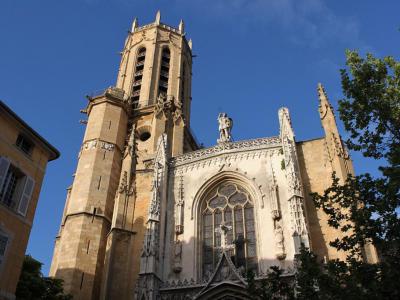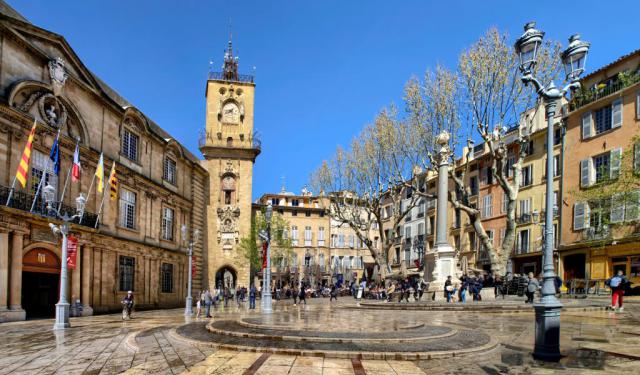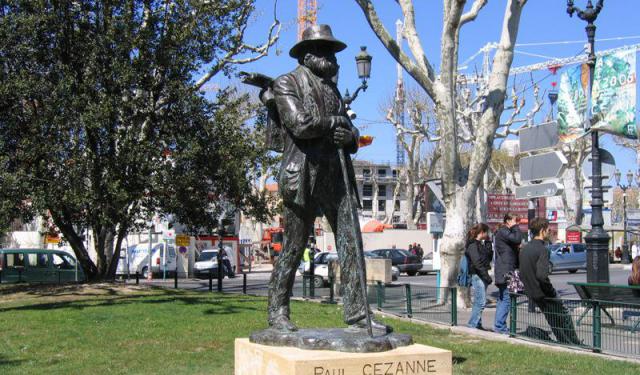
Cathedrale Saint-Sauveur d'Aix-en-Provence (Aix Cathedral), Aix-en-Provence (must see)
The 17th-century French writer and historian Jean Scholastique Pitton claimed the Aix Cathedral (Cathedrale Saint-Sauveur d'Aix-en-Provence) was built on the top of a Roman temple dedicated to Apollo, one of the Olympian deities in classical Greek and Roman religion and mythology. Tradition holds that the first church on the site was founded by Saint Maximinus in 500 AD. It is said that Maximinus arrived in Aix from Jerusalem with Mary Magdalene in a boat on loan from Saint Lazarus.
The current Cathedral of Aix was built in the 12th century. It had Romanesque walls and one wide nave. A second nave, dedicated to Saint Maximinus, was established between the first nave and the baptistry in 1171. Two new wings of the transept, built in the Gothic style, were added in 1318.
The main portal doors, made of carved red walnut, were installed in 1505. The western facade has extravagant Gothic portals. The yellowish buttresses have lengthy, narrow niches with pinnacles. Three statues of the Apostles stand on either side of the doorway. The remaining six Apostles hide in the side buttresses on each side.
Above the portal and gable, a statue of the archangel Michael, sculpted by Jean Paumier in 1507, skewers a supine dragon on the Gothic balustrade of the facade. The single 16th-century bell tower is 210 feet high.
The Aix Cathedral has a triple nave: a Romanesque side aisle, a Gothic central nave, and a Baroque 17th-century north aisle. The bishop's throne is in the Choir Gallery. The altar is supported by three bronze statues representing the Holy Trinity. The Baptistry Rotunda and its Roman columns date from the 5th century.
Artworks in the Cathedral include the Burning Bush Triptych (1475-1476) by French painter Nicolas Froment; Christ on the Cross (1640) and The Last Supper (1688) by Flemish artist Jean Daret; The Incredulity of Saint Thomas (1613) by Louis Finson, the follower of the famous Italian painter Caravaggio; the Altar of the Aygosi Family placed in the cathedral in 1823; and a set of 17 tapestries of the Life of Christ bought in 1656. The tapestries were woven in 1511 for Canterbury Cathedral in England and decorated the choir until 1642.
Paul Cezanne, the father of the cubist movement in France, was a native of Aix. He claimed it was the best place to live. He painted several canvases of the Aix Cathedral, a short walk from his studio. His funeral was held there in October 1906.
The current Cathedral of Aix was built in the 12th century. It had Romanesque walls and one wide nave. A second nave, dedicated to Saint Maximinus, was established between the first nave and the baptistry in 1171. Two new wings of the transept, built in the Gothic style, were added in 1318.
The main portal doors, made of carved red walnut, were installed in 1505. The western facade has extravagant Gothic portals. The yellowish buttresses have lengthy, narrow niches with pinnacles. Three statues of the Apostles stand on either side of the doorway. The remaining six Apostles hide in the side buttresses on each side.
Above the portal and gable, a statue of the archangel Michael, sculpted by Jean Paumier in 1507, skewers a supine dragon on the Gothic balustrade of the facade. The single 16th-century bell tower is 210 feet high.
The Aix Cathedral has a triple nave: a Romanesque side aisle, a Gothic central nave, and a Baroque 17th-century north aisle. The bishop's throne is in the Choir Gallery. The altar is supported by three bronze statues representing the Holy Trinity. The Baptistry Rotunda and its Roman columns date from the 5th century.
Artworks in the Cathedral include the Burning Bush Triptych (1475-1476) by French painter Nicolas Froment; Christ on the Cross (1640) and The Last Supper (1688) by Flemish artist Jean Daret; The Incredulity of Saint Thomas (1613) by Louis Finson, the follower of the famous Italian painter Caravaggio; the Altar of the Aygosi Family placed in the cathedral in 1823; and a set of 17 tapestries of the Life of Christ bought in 1656. The tapestries were woven in 1511 for Canterbury Cathedral in England and decorated the choir until 1642.
Paul Cezanne, the father of the cubist movement in France, was a native of Aix. He claimed it was the best place to live. He painted several canvases of the Aix Cathedral, a short walk from his studio. His funeral was held there in October 1906.
Want to visit this sight? Check out these Self-Guided Walking Tours in Aix-en-Provence. Alternatively, you can download the mobile app "GPSmyCity: Walks in 1K+ Cities" from Apple App Store or Google Play Store. The app turns your mobile device to a personal tour guide and it works offline, so no data plan is needed when traveling abroad.
Cathedrale Saint-Sauveur d'Aix-en-Provence (Aix Cathedral) on Map
Sight Name: Cathedrale Saint-Sauveur d'Aix-en-Provence (Aix Cathedral)
Sight Location: Aix-en-Provence, France (See walking tours in Aix-en-Provence)
Sight Type: Religious
Guide(s) Containing This Sight:
Sight Location: Aix-en-Provence, France (See walking tours in Aix-en-Provence)
Sight Type: Religious
Guide(s) Containing This Sight:
Walking Tours in Aix-en-Provence, France
Create Your Own Walk in Aix-en-Provence
Creating your own self-guided walk in Aix-en-Provence is easy and fun. Choose the city attractions that you want to see and a walk route map will be created just for you. You can even set your hotel as the start point of the walk.
Aix-en-Provence Introduction Walking Tour
Aix-en-Provence is a city in southern France, about 30 km (or 20 mi) north of Marseille. Aix was founded by Roman Consul Sextius Calvinus in 123 BC. Calvinus called it Aquae Sextiae, which means "Waters of Sextius," after the warm springs in the area. During the Middle Ages, it was the capital of Provence.
Aix reached a high point after the 12th century as it began to emerge as a... view more
Tour Duration: 1 Hour(s)
Travel Distance: 1.7 Km or 1.1 Miles
Aix reached a high point after the 12th century as it began to emerge as a... view more
Tour Duration: 1 Hour(s)
Travel Distance: 1.7 Km or 1.1 Miles
In the Footsteps of Paul Cézanne
Paul Cezanne created a scandal. While staying at the home of Doctor Paul Gachet in Auvers-sur-Oise, he painted an homage to Edouard Manet's work, Olympia, based on Titian's Venus of Urbino. Titian painted a goddess. Manet painted a prostitute. In his "New Olympia," Cezanne painted himself in the painting.
The nude New Olympia, seemingly a muse, reclines on her couch.... view more
Tour Duration: 2 Hour(s)
Travel Distance: 3.0 Km or 1.9 Miles
The nude New Olympia, seemingly a muse, reclines on her couch.... view more
Tour Duration: 2 Hour(s)
Travel Distance: 3.0 Km or 1.9 Miles
Aix-en-Provence Fountains and Squares Tour
Aix-end-Provence is known for its fountains. With more than 1,000 fountains, a tourist could spend weeks walking around the city without glimpsing them all. The fountains began appearing under the Roman empire when the Romans discovered Aix's natural thermal water source. They referred to the area as Aquae Sextiae or the Waters of Sextius.
The fountains appear throughout the city and are... view more
Tour Duration: 1 Hour(s)
Travel Distance: 1.6 Km or 1 Miles
The fountains appear throughout the city and are... view more
Tour Duration: 1 Hour(s)
Travel Distance: 1.6 Km or 1 Miles



